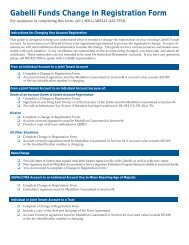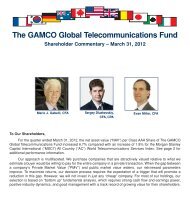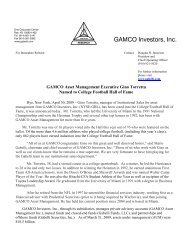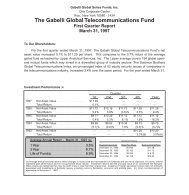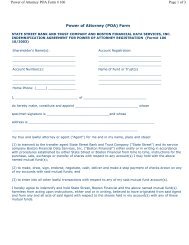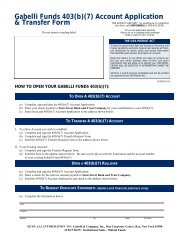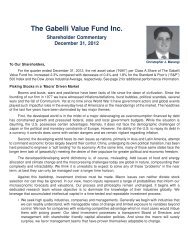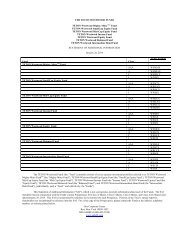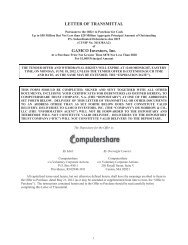FORM 10-K/A GAMCO Investors, Inc. - Gabelli
FORM 10-K/A GAMCO Investors, Inc. - Gabelli
FORM 10-K/A GAMCO Investors, Inc. - Gabelli
- No tags were found...
You also want an ePaper? Increase the reach of your titles
YUMPU automatically turns print PDFs into web optimized ePapers that Google loves.
Recent Accounting Developments<br />
In February 2006, the FASB issued FASB Statement No. 155, “Accounting for Certain Hybrid Financial Instruments – an amendment of FASB Statement No. 133 and<br />
140,” (“Statement 155”) that amends FASB Statements No. 133 “Accounting for Derivative Instruments and Hedging Activities,” (“Statement 133”) and No. 140 “Accounting for<br />
Transfers and Servicing of Financial Assets and Extinguishments of Liabilities.” (“Statement 140”). The statement permits fair value remeasurement for any hybrid financial<br />
instrument that contains an embedded derivative that otherwise would require bifurcation; clarifies which interest-only strips and principal-only strips are not subject to the<br />
requirements of Statement 133; establishes a requirement to evaluate interests in securitized financial assets to identify interests that are freestanding derivatives or that are hybrid<br />
financial instruments that contain an embedded derivative requiring bifurcation; clarifies that concentrations of credit risk in the form of subordination are not embedded derivatives;<br />
amends Statement 140 to eliminate the prohibition on a qualifying special-purpose entity from holding a derivative financial instrument that pertains to a beneficial interest other than<br />
another derivative financial instrument. Statement 155 does not permit prior period restatement. The statement is effective for all financial instruments acquired or issued after the<br />
beginning of an entity’s first fiscal year that begins after September 15, 2006. The Company plans to adopt this statement on January 1, 2007. The impact of adopting this<br />
statement is expected to be immaterial to the Company’s consolidated financial statements.<br />
In March 2006, the FASB issued FASB Statement No. 156, “Accounting for Servicing of Financial Assets,” which amends Statement 140. The statement permits an entity to<br />
choose either the amortization method or fair value measurement method for each class of separately-recognized servicing assets and servicing liabilities. The statement is effective<br />
as of the beginning of an entity’s first fiscal year that begins after September 15, 2006. The Company plans to adopt this statement on January 1, 2007. The impact of adopting this<br />
statement is expected to be immaterial to the Company’s consolidated financial statements.<br />
In April 2006, the FASB issued FSP FIN 46R-6 “Determining the Variability to be Considered in Applying FASB Interpretation No. 46(R) (“FSP”)” The FSP addresses certain<br />
major implementation issues related to FIN 46R, specifically how a reporting enterprise should determine the variability to be considered in applying FIN 46R. The FSP is effective<br />
as of the beginning of the first day of the first reporting period beginning after September 15, 2006. The Company plans to adopt this statement on January 1, 2007. The impact of<br />
adopting this statement is expected to be immaterial to the Company’s consolidated financial statements.<br />
In June 2006, the FASB issued Interpretation No. 48, “Accounting for Uncertainty in <strong>Inc</strong>ome Taxes” (“FIN 48”), which is an interpretation of FASB Statement No. <strong>10</strong>9,<br />
“Accounting for <strong>Inc</strong>ome Taxes” (“FAS<strong>10</strong>9”). This interpretation prescribes a recognition threshold and measurement attribute for the financial statement recognition and<br />
measurement of a tax position taken or expected to be taken in a tax return. This interpretation is effective for fiscal years beginning after December 15, 2006. The Company plans<br />
to adopt this interpretation on January 1, 2007. The Company has not completed its analysis, and the materiality of the adoption on the Company’s consolidated financial statement<br />
is not known at this time.<br />
In September 2006, the FASB issued FASB Statement No. 157, “Fair Value Measurement” (“Statement 157”). The statement provides guidance for using fair value to measure<br />
assets and liabilities. The statement provides guidance to companies about the extent of which to measure assets and liabilities at fair value, the information used to measure fair<br />
value, and the effect of fair value measurements on earnings. The statement applies whenever other standards require (or permit) assets or liabilities to be measured at fair value. The<br />
statement does not expand the use of fair value in any new circumstances. The statement is effective for financial statements issued for fiscal years beginning after November 15,<br />
2007 and for interim periods within those fiscal years. The Company plans to adopt this statement on January 1, 2008. The impact of adopting Statement 157 is expected to be<br />
immaterial to the Company’s consolidated financial statements.<br />
In September 2006, the SEC released Staff Accounting Bulletin No. <strong>10</strong>8 (the “SAB”), "Considering the Effects of Prior Year Misstatements when Quantifying Misstatements in<br />
Current Year Financial Statements". The SAB addresses diversity in how companies consider and resolve the quantitative effect of financial statement misstatements. The SAB is<br />
effective as of the beginning of the first day of the first reporting period beginning after November 15, 2006. The Company plans to adopt this SAB on January 1, 2007. The<br />
impact of adopting this SAB is expected to be immaterial to the Company’s consolidated financial statements.<br />
63



